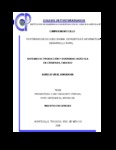Sistemas de producción y diversidad agrícola en Cárdenas, Tabasco
Abstract
En el estado de Tabasco, En 1951 se buscó reorganizar las unidades productivas en el campo la
producción agropecuaria a escala comercial, lejos de cumplir el objetivo se afectó la biodiversidad de
especies de plantas por la deforestación, provocando un grave deterioro en el agroecosistemas.
Para el presente estudio se realizó para determinar la diversidad de especies de plantas y su
manejo. Se registró las características sociodemográficas del jefe de familia, las prácticas agrícolas
en el traspatio y parcela, prácticas agroecológicas en la región y las prácticas agrícolas
institucionales. La mayoría de los productores son de avanzada edad. En el traspatio se puede
encontrar una gran diversidad de especies de plantas de consumo familiar que van desde las
hortalizas, árboles frutales, plantas medicinales y ornamentales, las labores de cultivo son
rudimentarias y la dependencia de insumos químicos es limitado. En la parcela se encontró que los
principales cultivos son la caña y el cacao. Se encontró a productores que utilizan un sistema
agrícola adecuado, tal es el caso del denominado maíz marceño y el de cobertura con leguminosas
asociado con el cultivo de maíz. Así mismo, se comprueba que la agricultura a pequeña escala y con
fines de autoconsumo tiene un mayor grado de prácticas agroecológicas, tendientes a la agricultura
sustentable._____________In 1951, in the state of Tabasco there was an attempt to reorganize the structure of
agricultural and cattle farming units on a commercial scale. However, far from
achieving any success the diversity of plant species was affected due to
deforestation, causing severe degradation of local agroecosystems.
This study determines the diversity of plant species and their management, starting
by registering the socio-demographic characteristics of the family representatives
(the men), the farming activities both in the “solar” and in the farming plot, as well
as some institutional and agroecological farming practices in the region.
Most producers are elderly people. The “solar” is a highly diversified unit where it is
possible to find a variety of plant species to satisfy some of the household needs
such as vegetables, fruits, medicinal and ornamental plants. The labor in the plots
is rudimentary and the dependency of chemical inputs is limited. The main crops of
the farming plot are sugar cane and cocoa. This study revealed the existence of
accurate cultural practices among some of the producers, as in the case of the
“marceño” corn culture and the association of corn-leguminose. It was proved that
small-scale and subsistence oriented agriculture incorporates a much higher
number of agroecological practices which make it closer to being a sustainable
activity.
Collections
- Tesis MC, MT, MP y DC [317]

